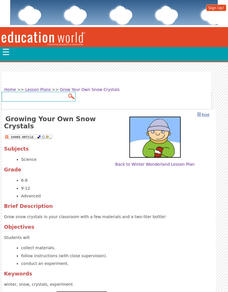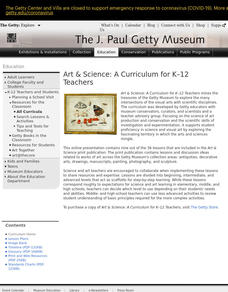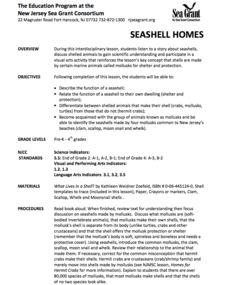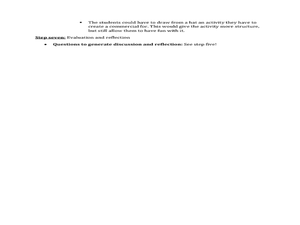Curated OER
Review of the Five Senses
Students investigate the five senses. In this human biology lesson, students are given five items and identify which items match best with each of the senses. Students use objects such as a rock, hard candy, and a flower.
Curated OER
Growing Your Own Snow Crystals
Students grow snow crystals in your classroom with a few materials and a two-liter bottle!
Curated OER
Pika Chew
Students work in collaborative teams with specific roles, use the Internet to research the behavior and ecology of pikas, make predictions about survival rates of pikas in different habitats and organize their data in graphs.
Curated OER
Horns or Antlers-You Decide!
Students study the difference between horns and antlers. They identify animals who have each and draw pictures of these animals. They experience samples of actual horns and antlers.
Curated OER
What's Wrong With Nuclear Power, Anyway?
Students see that the production and use of nuclear energy has been both praised and condemned as a source of electrical power for our daily living. They examine the reasons for the conflict of opinions in our society.
Curated OER
Time Travel to the Edge of the Universe and Back!
Learners analyze the size of the universe and calculate the time to travel to near and distant destinations.
Curated OER
Technology: Koo Koo for Clocks
Third graders design and make clocks compiling a materials list, creating adesign portfolio, and recording progress in a daily log. After making a full-size drawing of their clocks and with the assistance of high school technology...
Curated OER
Biodiversity Count
Students count the number of species they can find in a five minute block of time in both an urban lawn and natural, remnant forest area. They are introduced to the concept of low and high biodiversity areas and engage in a discussion...
Curated OER
Design and Construction of an Eco-House
Students are able to design, construct, evaluate and recommend materials for planned Eco-house to be built on campus. They investigate about good design and plan for construction. Students have a greater knowledge and appreciation of...
Curated OER
Finding Balance
Young scholars examine the relationships between force, mass and balance through the lens of clay sculpture. They discuss the definitions and concepts behind Newton's Third Law of motion then individually apply these principles to the...
Alabama Learning Exchange
Making and Observing Life in a Terrarium
Young scholars understand the parts of the terrarium and why they are important in establishing an ecosystem. In this ecosystem lesson, students recall background information on aquariums, terrariums and the water cycle. Young scholars...
Curated OER
Investigating Animals in Soil
Students investigate and observe small animal activity on a plot of land on their school grounds. In small groups they identify the five kingdoms of animals, stake out a small plot of ground, collect samples, record and analyze any data...
Curated OER
Earthquakes and Volcanoes
In this earthquakes and volcanoes worksheet, students use an on line source to answer questions about earthquakes around the world, the origins of volcanoes and the creation of lava tube caves.
Curated OER
Hovercraft
Students assess human impact on water quality. They determine how the force of friction retards motion. Pupils describe and measure quantities that characterize moving objects and their interactions within a system: Time, Distance,...
Curated OER
TE Lesson: Can You Taste It?
Students investigate how animals adapt to use its senses to identify foods that are nutritious or noxious. They determine how they associate foods with other things such as birthdays. They discuss the role of the nervous system in the...
Curated OER
Clearly Classified
Young scholars review the classification system for living organisms and apply it the classification of insects and flowers in the still life by Ambrosius Bosschaert. They create a chart classifying the animals and plants in the painting...
Curated OER
So You Think You're Tough
Fourth graders learn how to classify animals. In this invertebrates lesson, 4th graders discuss how we classify thinks into groups and move into a discussion about classifying animals. Students learn about the differences between...
Curated OER
Seashell Homes
Pupils listen to a story about seashells. They discuss shelled animals. Learners describe the function of seashell. Pupils relate the function of a seashell to their own dwelling. They differentiate between shelled animals that make...
Curated OER
Ben Franklin's Inventions
Students discover the life of Benjamin Franklin by studying his inventions. In this biography lesson, students identify the inventions of Benjamin Franklin and their impact on society today. Students create a commercial in an...
Curated OER
Kids Negotiating the Electronic Superhighway-Self Care & Repetition Injuries
Students arrange, recognize and illustrate the connection of body movements to technology to injury. Students explore their findings to examine the statistics to their own personal lives. Students focus on a variety of resources to...
Curated OER
Fizzy Pop
Fifth graders compare and identify variables that affect the rate of a chemical change using Alka-Seltzer, water, ice, and hot water. They time how long each variable takes to pop the canister into the air, and record the results on a...
Curated OER
Homopolar Motor Experiments
Students construct a homopolar motor following certain procedures. In this physics instructional activity, students explain how generators and motors work. They compare and contrast the characteristics of both.
Curated OER
Maglev Trains
Students explore how Maglev trains work. In this technology instructional activity, students discuss the pros and cons of Maglev compared to conventional trains. They build a simple Maglev train model.























